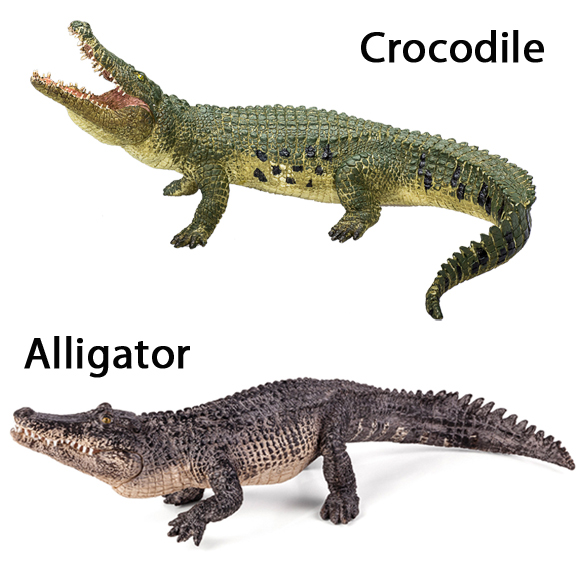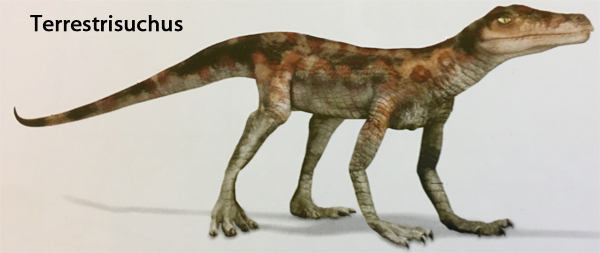Crocodiles can Gallop but Alligators Can’t
A study led by Royal Veterinary College staff has identified more species of crocodiles that can move quickly by adopting a galloping gait. In contrast, the closely related alligator and caiman, cannot manage more than a trot. Ironically, despite differences in locomotion, crocodiles and alligators can all move at approximately the same speed, which no more than around 11 miles per hour (4.9 metres per second). The ability to gallop and to use an even more extreme gait called a bound, is likely down to the size and build of the member of the family Crocodylia in question.
The Locomotion Study of Crocodilians Revealed Different Gaits

Picture credit: Everything Dinosaur
Studying Living Crocodiles Provides Information about Extinct Crocodilians
Members of the Crocodylia employ almost the full range of quadrupedal footfall patterns (gaits) used by mammals. These forms of movement on land include asymmetrical gaits such as galloping and bounding. Researchers at the Royal Veterinary College set up video tracking cameras at the St Augustine Alligator Farm and Zoological Park in Florida (USA), in order to plot the movements of different crocodilians.
The St Augustine Alligator Farm houses a large number of different species and lots of different animals at various growth stages, it makes an ideal location at which to study crocodilian locomotion. The Park has been involved in numerous studies, including one conducted by University of Ohio researchers that looked at ways in which archosaurs may have helped to keep their brains cool. To read more about this research: T. rex had Air Conditioning.
In total the gaits and velocity of forty-two reptiles from fifteen species were studied.
Five Additional Crocodile Species Can Gallop and Bound
The researchers found that, as expected, larger animals moved relatively more slowly, with athletic ability decreasing as size and bulk increases. However, while many popular and scientific accounts previously assumed only a few species of crocodiles could gallop and bound, the scientists discovered that a further five species can in fact do so, including the critically endangered Philippine crocodile (Crocodylus mindorensis). This now means at least eight species in total can gallop and bound.
Professor John Hutchinson, (Royal Veterinary College), commented:
“We were really surprised at one major thing: despite the different gaits crocodiles and alligators use, they all can run about as fast. So why do some crocodiles choose to gallop? We suspect that bounding and galloping give small crocodiles better acceleration and manoeuvrability, especially useful for escaping from danger. It seems like alligators and caiman stand their ground rather than run away with an extreme gait.”
John Brueggen, Director of St Augustine Alligator Farm and Zoological Park, added:
“We have been witnessing these behaviours in many of our specimens over the years, but it was wonderful to finally formalise these observations in a scientific study.”
Triassic Origins?
The ancestors of today’s crocodilians tended to be small, much more terrestrial in habit and long-legged. Stem members of the Crocodylomorpha, such as Terrestrisuchus (illustrated below), needed to be fast runners in order to catch their prey and to avoid being eaten by larger predators. The researchers suggest that either that asymmetrical gaits are ancestral for Crocodylia and lost in the alligator lineage, or that asymmetrical gaits evolved within Crocodylia at the base of the crocodile branch of the family tree.
Terrestrisuchus – A Genus of Early Crocodylomorph from the Late Triassic

Recently, Everything Dinosaur published an article that examined another piece of research conducted by the scientists at the Royal Veterinary College, the paper focused on the giant caiman Purussaurus (P. mirandai), from the Late Miocene of Venezuela. This monstrous crocodilian evolved unique anatomical adaptations to help it move around on land.
Read the article about Purussaurus here: Ancient Crocodilian Evolved Unique Specialisations Due to its Size.
The scientific paper: “Divergent evolution of terrestrial locomotor abilities in extant Crocodylia” by John R. Hutchinson, Dean Felkler, Kati Houston, Yu-Mei Chang, John Brueggen, David Kledzik and Kent A. Vliet published in the journal scientific research.
Everything Dinosaur acknowledges the assistance of a press release from the Royal Veterinary College in the compilation of this article.
The Everything Dinosaur website: Everything Dinosaur.






Leave A Comment